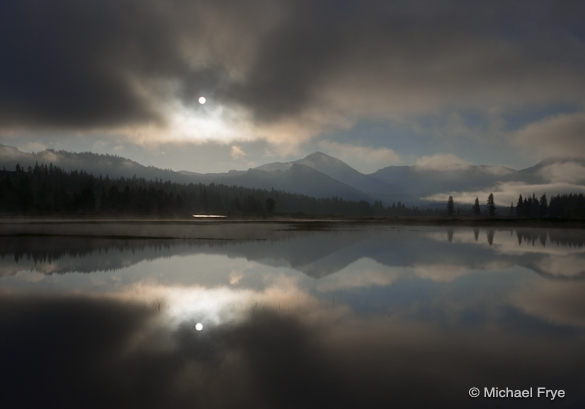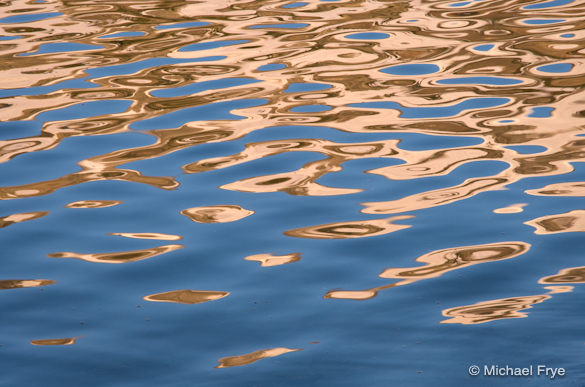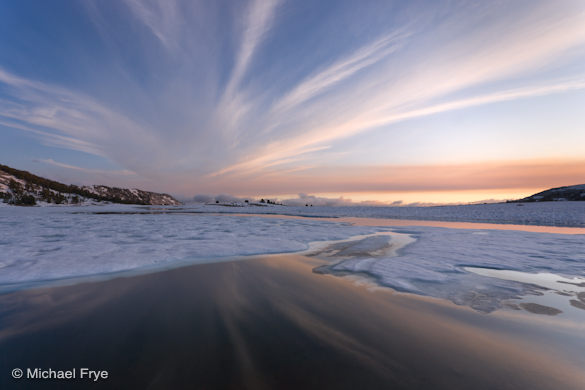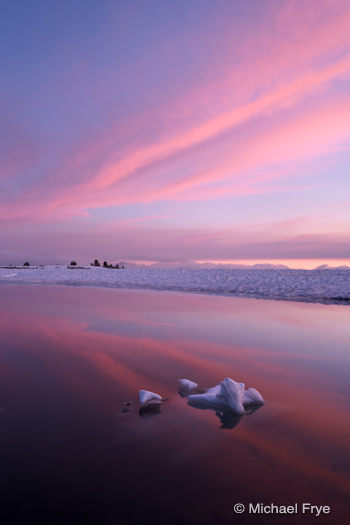Landscape photographers have to be flexible. You can try to plan—to be at a certain place at a certain time when you expect the light to be just right. But you can’t control the weather, and the best-laid plans of photographers often fizzle behind a bank of clouds.
So when things don’t pan out the way you’d hoped, you have to adapt. We did a lot of adapting last week during my Hidden Yosemite workshop. With our heavy winter and late spring, there was still a lot of snow at higher elevations. Certain areas were just inaccessible; the Saddlebag Lake road, for example, was closed, and I heard the lake was still mostly covered in ice.
And then some strange weather arrived, with low-lying clouds forming in the afternoons. On Thursday, our second evening, the weather completely closed in and blocked any late-day light.
But things usually even out, and “bad” weather one day often leads to exceptional conditions the next. Friday morning we rose early to photograph the moon setting over Tenaya Lake. Driving through Tuolumne Meadows we hit a bank of low-lying clouds, and found overcast skies at the lake.
We were about to go back to Tuolumne when the moon poked through a hole in the clouds. I took this as a sign, so we stayed. The clouds started to break, and we ended up getting some nice photos of the setting moon.
We returned to Tuolumne Meadows and found it completely socked in. But I knew the fog bank would burn off, so we waited. Soon we could see some breaks in the clouds, and then we were treated to a fantastic light show as the sun burned through the mist (see the photo at the top of this post).
Friday evening we climbed up to Gaylor Lakes, and found the middle lake still about eighty-percent ice-covered. While this prevented us from making classic reflection images from this spot, it gave us something perhaps better—the opportunity to photograph ice formations. Somehow hazy sunshine turned into a spectacular sunset, with that ice providing a great foreground.
So we had some great light and some not-so-great light; par for the course. We did what you have to do in such situations—we tried to adapt, and take advantage of the circumstances. Unusual conditions can lead to special photographs.
Most importantly, we had a great time. For this workshop we say up front that we’re going to do some hiking and you have to be in good physical condition to attend. While the hikes are not long, the high altitude makes them more difficult. The reward for the hiking is getting to great spots that you just can’t drive to. And being away from the crowds in such beautiful places, with a wonderful group of people who share the same passion for photography, makes it a special experience.
—Michael Frye
Related Posts: Yosemite Valley Under Water, Tioga Pass Opens
Michael Frye is a professional photographer specializing in landscapes and nature. He is the author and photographer of The Photographer’s Guide to Yosemite, Yosemite Meditations, and Digital Landscape Photography: In the Footsteps of Ansel Adams and the Great Masters, plus the eBook Light & Land: Landscapes in the Digital Darkroom. He has written numerous magazine articles on the art and technique of photography, and his images have been published in over thirty countries around the world. Michael has lived either in or near Yosemite National Park since 1983, currently residing just outside the park in Mariposa, California.













Sounds like the workshop was fun and a great success. These photos are great but you’d never know they were made in Yosemite. Very original.
Oh man!! That’s sweet. I saw the moonset Friday morning in Oakdale just as I was heading to the park. I saw the last edge of that same mist at about 8:30 at Olmsted Point on the way to Tuolumne. When do we get to see the moonset photo. I was amazed how pretty it looked from the Shell Gas Station. (Not quite the same scenic setting as Tenya Lake though.)
Hi Michael. I love the sun breaking thru the mist. the natural, near-monochromatic, layered scene makes a beautiful image. One of my favorite types. The partially frozen lake makes the sunset or clouds much more interesting. Very nice set.
I’d love the see the moonset too! Your mention is a teaser. The clouds over Tioga Lake are fantastic…the perfect lead in lines and vanishing point. They may not have been the expected scenes, but they certainly are unique scenes.
A wonderful collection of images Michael – I particularly like the main image.
Great images.
And photographers, landscape or other, must be flexible and be able to think fast on their feet.
Whether its changing weather conditions, unexpected barriers, or the fast pace of breaking news, taking moment to read the scene is vital to capturing a great image.
Thanks Michael.
I have to give my vote to the last one. Great soft colors and soft overall feeling to the shot. The ice is a great anchor!
Thanks very much everyone – glad you like the photos!